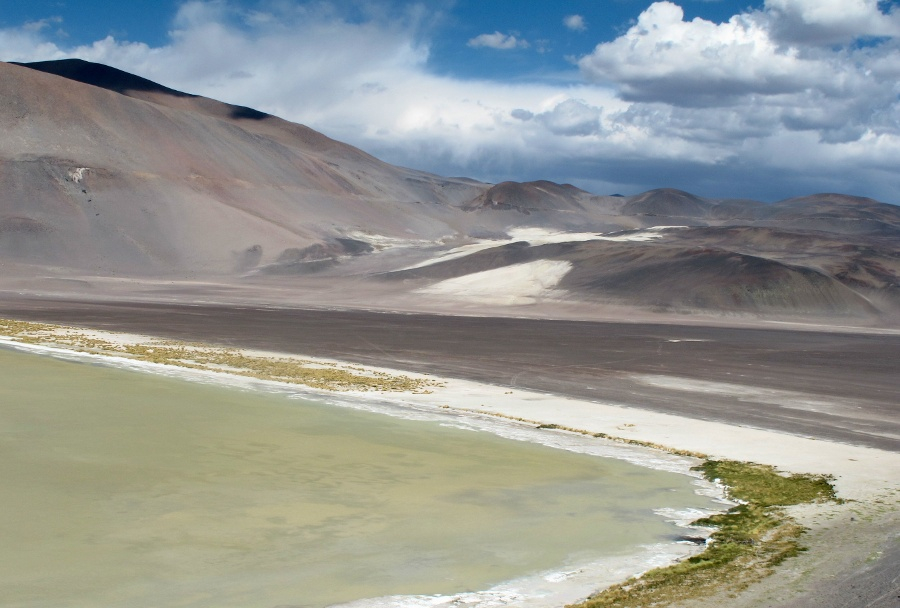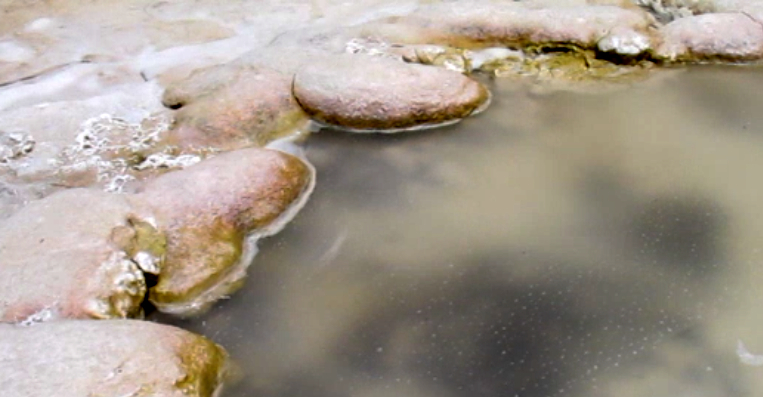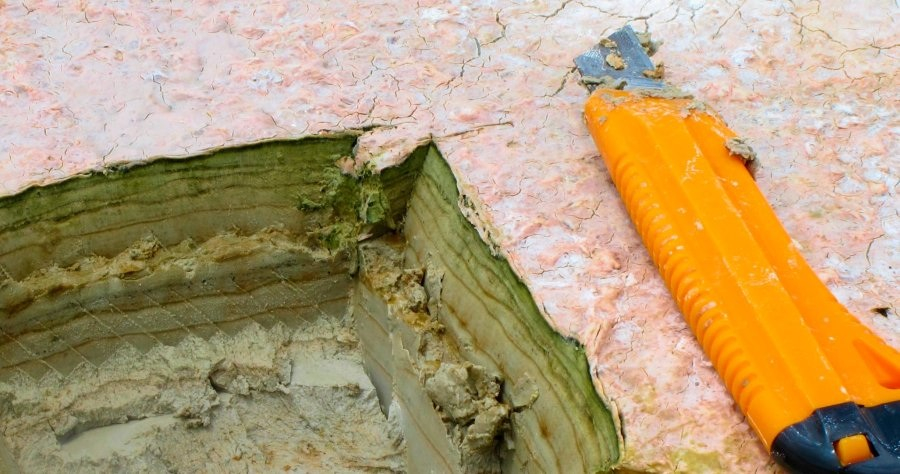Page path:
- Press Office
- Press releases 2013
- 16.01.2013 Stromatolites from a high-altitude v...
16.01.2013 Stromatolites from a high-altitude volcanic lake
An Argentinean-German research team led by Lubos Polerecky of the Max Planck Institute for Marine Microbiology has examined stromatolites from the lake Socompa, a volcanic lake located in the Andes at the border between Argentina and Chile. At 3570 m above sea level, this is so far the highest altitude where these structures have been reported (Fig.1). Lubos Polerecky, who won the Biomaris Award in 2010, announced at that time to use the award for the investigation of the Argentinean high-altitude lakes. A detailed description of the Socompa stromatolites, which has been recently published in the scientific journal PLOS One, is the first fruit of this collaborative investigation.
Figure 1: Socompa lake is situated at 3570 m above sea level and represents the highest altitude at which actively forming stromatolites have ever been reported. Photo: L. Polerecky
Stromatolites are domical structures that show a characteristic lamination (Fig. 2 A and B). The stromatolites form by trapping, precipitation and binding of calcareous deposits. Cyanobacteria are the predominant inhabitants of the stromatolite structure. Fossil stromatolites constitute our earliest and most pervasive record of life on Earth. Therefore, studying living stromatolites gives us an opportunity to better understand the Earth’s past. At present, actively forming stromatolites are typically, but not exclusively, found in aquatic environments with extreme life conditions.
Figure 2 A: Typical stromatolites with their domical shape. Due to the volcanic activity the water temperature of the water surrounding the Stromatolites is 20-24°C. Photo: L. Polerecky
In 2009, Dr. María E. Farías, a scientist at the Argentinean research institution CONICET and a lead author of the PLOS One study, discovered stromatolites forming at a shore of a high-altitude Andean lake called Socompa. Owing to their location high up in the mountains and near still active volcanoes, the conditions at the stromatolite site are harsh: salinity is about 3-fold higher than in seawater, arsenic concentrations are about 3 orders of magnitude above safety limits for drinking water, and the exposure to UV radiation is among the highest on this planet. “Considering these extremes, the microbial community forming these stromatolites is very diverse and unusual”, says Lubos Polerecky. The community contains unusually abundant representatives of Deinococcus-Thermus as well as many of novel and phylogenetically distant microbial lineages “Our current hypothesis is that the diverse community is maintained through its particular spatial organization: Representatives of Deinococcus-Thermus, some of which are known for their UV resistance, reside at the stromatolite surface and feed on the organic matter released by the highly productive cyanobacteria residing underneath. In return, by their special pigmentation, they provide an efficient shelter for the cyanobacteria against the deadly UV radiation,” adds Dr. Polerecky.
Figure 2 B: Sectioning the deposits reveals the clear-cut layers of the stromatolite. The photosynthetic pigments of the cyanobacteria colourize the green layers. Photo: L. Polerecky
Because of their capacity to thrive in an environment characterized by a multitude of extremes, the Socompa stromatolites are an excellent model system for studying microbial adaptations under conditions that, at least in part, resemble those during the early phase of life evolution on Earth. Additionally, the high abundance of distant and undescribed microbial lineages suggests that the stromatolites may harbor novel gene and protein resources of potential biotechnological interest. “These are two main reasons why this special habitat, which is acutely threatened by mining prospects, should be actively protected,” concludes Dr. Polerecky.
For more information
Dr. Lubos Polerecky, +49 421 2028 834 [Bitte aktivieren Sie Javascript]
Press office
Dr. Rita Dunker +49 421 2028 856 [Bitte aktivieren Sie Javascript]
Dr. Manfred Schlösser +49 421 2028 704 [Bitte aktivieren Sie Javascript]
Involved institutions
Max Planck Institute for Marine Microbiology, Bremen, Germany
Centro de Investigaciones Geológicas, Universidad Nacional de La Plata-CONICET, La Plata, Argentina
Max Planck Institute for Chemical Energy Conversion, Mülheim an der Ruhr, Germany
Instituto de Agrobiotecnologia Rosario (INDEAR), Rosario, Santa Fe, Argentina
Instituto de Biotecnología y Biología Molecular (IBBM), Universidad Nacional de La Plata-CONICET, La Plata, Argentina
Facultad de Ciencias Naturales e Instituto Miguel Lillo, Universidad Nacional de Tucumán, San Miguel de Tucumán, Tucumán, Argentina
Laboratorio de Investigaciones Microbiológicas de Lagunas Andinas (LIMLA), Planta Piloto de Procesos Industriales Microbiológicos (PROIMI), CCT, CONICET, San Miguel de Tucumán, Tucumán, Argentina
Original article
The Discovery of Stromatolites Developing at 3570 m above Sea Level in a High-Altitude Volcanic Lake Socompa, Argentinean Andes (2013). Farías ME, Rascovan N, Toneatti DM, Albarracín VH, Flores MR, Poiré DG, Collavino MM, Aguilar OM, Vazquez MP, Polerecky L. PLoS ONE 8(1): e53497.
Doi: 10.1371/journal.pone.0053497
For more information
Dr. Lubos Polerecky, +49 421 2028 834 [Bitte aktivieren Sie Javascript]
Press office
Dr. Rita Dunker +49 421 2028 856 [Bitte aktivieren Sie Javascript]
Dr. Manfred Schlösser +49 421 2028 704 [Bitte aktivieren Sie Javascript]
Involved institutions
Max Planck Institute for Marine Microbiology, Bremen, Germany
Centro de Investigaciones Geológicas, Universidad Nacional de La Plata-CONICET, La Plata, Argentina
Max Planck Institute for Chemical Energy Conversion, Mülheim an der Ruhr, Germany
Instituto de Agrobiotecnologia Rosario (INDEAR), Rosario, Santa Fe, Argentina
Instituto de Biotecnología y Biología Molecular (IBBM), Universidad Nacional de La Plata-CONICET, La Plata, Argentina
Facultad de Ciencias Naturales e Instituto Miguel Lillo, Universidad Nacional de Tucumán, San Miguel de Tucumán, Tucumán, Argentina
Laboratorio de Investigaciones Microbiológicas de Lagunas Andinas (LIMLA), Planta Piloto de Procesos Industriales Microbiológicos (PROIMI), CCT, CONICET, San Miguel de Tucumán, Tucumán, Argentina
Original article
The Discovery of Stromatolites Developing at 3570 m above Sea Level in a High-Altitude Volcanic Lake Socompa, Argentinean Andes (2013). Farías ME, Rascovan N, Toneatti DM, Albarracín VH, Flores MR, Poiré DG, Collavino MM, Aguilar OM, Vazquez MP, Polerecky L. PLoS ONE 8(1): e53497.
Doi: 10.1371/journal.pone.0053497



